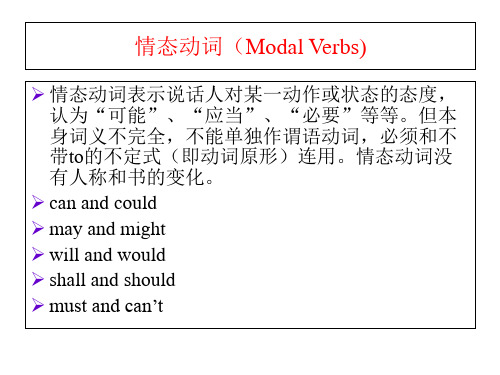初中英语情态动词公开课ppt课件
合集下载
情态动词讲解ppt课件

A. may B. might C. could
D. must
10
may, might, can, could
表示猜测
➢ 1. They (can/might) ___m__ig_h__t___be away for the
weekend but I’m not sure.
表示许可
➢ 2. You (may/might) __m__a_y_____leave now if you
1.A computer ____ think for itself; it must be told what to do.
A. can’t B. couldn’t C. may not D. might not
1.I thought you ________ like something to read, so I have brought you some books.
2.表示推测时,could不是过去式,只是语气 更委婉;若是推测已发生的事或过去的情况, 用can/could have done
7
3.can和be able to辨析 can(could)和be able to都可以表示能力,意思上没有区别。 但can只有现在式和过去式,而be able to则有更多的形式。 如:
3
Ⅲ 情态动词的语法特征 1) 情态动词不能表示正在发生或已经
发生的事情,只表示期待或估计某事的 发生。
2) 情态动词除ought 和have 外,后 面只能接动词原形。
3) 情态动词没有人称,数的变化,即 情态动词第三人称单数不加-s。
4) 情态动词没有非谓语形式,即没有 不定式,分词,等形式。
1.It may rain this afternoon. 2.She might come to join us this afternoon. 3.I suppose he might have missed the train.
情态动词(20张PPT)初中英语专项复习课件

看法。
(1)只作情态动词:must;can/could;may/might;ought to
(2)既可作情态动词又可作实义动词:need,dare
((34))既 具可 有作 情情 态态 动动词词某又些可特作征稿稿定助:定hPa动PPvTP,e词T/海h:量asd素ha材tlo持l;/s续hha更odublde;twteirll/would
【知识拓展】
1. must的一般疑问句,肯定回答为Yes, ...must.;否定回答为No, ...needn’t./No, ...don’t have
to.—Must I clean the classroom now? 我必须现在打扫教室吗?
—Yes, you must. 是的,你必须。/No, you don’t have to. /No, you needn’t. 不,你不必。
He promised he would never smoke again. 他承诺他再也不吸烟了。
Their English teacher would tell them stories in
表示过去反复发生的动 English after class.
作或某种倾向
他们的英语老师总是在课后用英语给他们讲故事
新,上千款模板选择总有一
款适合你
知识点二:情态动词的特点
情态动词的特点: (1)情态动词无人称和数的变化(have to除外); (2)情态动词后接动词原形; (3)情态动词的否定式是在其后加not; have to除外 (4)具有助动词的作用,可用来构成否定句、疑问句及用于简明答语; (5)个别情态动词有现在式和稿过定去PP式T两种形式,过去式用来表达更加客气、委 婉的语气,时态性不强,可稿用定于PPT过,海去量、素材现持在续更或将来。
(1)只作情态动词:must;can/could;may/might;ought to
(2)既可作情态动词又可作实义动词:need,dare
((34))既 具可 有作 情情 态态 动动词词某又些可特作征稿稿定助:定hPa动PPvTP,e词T/海h:量asd素ha材tlo持l;/s续hha更odublde;twteirll/would
【知识拓展】
1. must的一般疑问句,肯定回答为Yes, ...must.;否定回答为No, ...needn’t./No, ...don’t have
to.—Must I clean the classroom now? 我必须现在打扫教室吗?
—Yes, you must. 是的,你必须。/No, you don’t have to. /No, you needn’t. 不,你不必。
He promised he would never smoke again. 他承诺他再也不吸烟了。
Their English teacher would tell them stories in
表示过去反复发生的动 English after class.
作或某种倾向
他们的英语老师总是在课后用英语给他们讲故事
新,上千款模板选择总有一
款适合你
知识点二:情态动词的特点
情态动词的特点: (1)情态动词无人称和数的变化(have to除外); (2)情态动词后接动词原形; (3)情态动词的否定式是在其后加not; have to除外 (4)具有助动词的作用,可用来构成否定句、疑问句及用于简明答语; (5)个别情态动词有现在式和稿过定去PP式T两种形式,过去式用来表达更加客气、委 婉的语气,时态性不强,可稿用定于PPT过,海去量、素材现持在续更或将来。
初中英语情态动词-(演示)-课件PPT

在回答以must开头的一般疑问句时,
➢ 考点揭密 否定式需用need not (needn’t),表示 “不必”的意思。如:
— Must we hand in our exercises
today?
3 must
— Yes, you must. ( No, you needn’t)
must 表示必须要做的事,意为“必须,应该”。must一般
1 can can 可表示能力、允许、可能性、怀疑猜测,意为“能, 会,可以”;can't意为“不会,不能,不可以”,还有 “不可能”之意。could为can的过去式,用法与can类似 ,常用于过去时中;could还可用于现在时中表示委婉客 气,相当于can;could也可表示惊讶怀疑,不相信,如: He couldn't be a thief.
➢ 重难点解析
二者所强调的意思不同。一般来说,can强调客观上的可 能性,而may则强调主观上的推测或判断。如: Man cannot live without air or water. She may be in the library, I suppose. She may not be there today.
➢ 重难点解析
二者表示的语气不同。在否定句中,can表达的否定语气 较强,意为“不可能”;而may表达的否定语气较弱,意 为“可能不”或“也许不”。如: That cannot be true. (=It is impossible that that is true.) That may not be true. (=It is possible that that is not true.)
根据以上分析,我们可以归纳为三条原则: (1) 在肯定句中用may不用can; (2) 在疑问句中用can不用may; (3) 在否定句中,若语气肯定,表示“不可能”时用can
情态动词(17张PPT)初中英语专项复习课件

情态动词表推测也是每年中考的重点,以考查can’t 和must为主,主要在单项选择中考查不同情态动词的辨 析。考生在解答此类试题时,可以从以下几方面着手: ①表示否定的推测:一是断然的否定,此类题一般是考 查情态动词表推测的用法,语境会对所填空给出解释, 据 此 可 以 判 断 是 非 常 肯 定 的 否 定 , 此 时 最 好 用 cannot /can’t;二是表示不能十分肯定或拿不准,此类题一般 也会有相关的语境提示,如I’m not sure、who knows等 ,此时最好用may或might。
表示需要、必须,主 要用于否定句和疑问 句中。needn’t常用 于回答must表请求的 否定回答
—Must I finish my homework now?我必 须现在完成我的家庭作 业吗? —No, you needn’t. 不, 你不需要。
注意 (1) must和have/has to均意为“必须”,常可互 换使用。但have/has to是用于强调客观需要,意为 “必须, 不得不”;must用于表示主观看法, 意为“ 必须, 应该”。如:We’ll have to ask Zhang Hong. 我们必须去问张红了。 We must work hard at school. 在学校我们必须 努力学习。
情态动词本身有一定的意义,但不能独立作谓语, 没有人称和数的变化,后面必须接动词原形。常见的情 态动词有:may, must, need, have to 等,具体用法见下表 :
情态动词
用法
例句
表示能力,意为 Sam can speak English well.
can “能,会”
山姆英语讲得很好。
He could have gone home. 他可能已回家了。
表示需要、必须,主 要用于否定句和疑问 句中。needn’t常用 于回答must表请求的 否定回答
—Must I finish my homework now?我必 须现在完成我的家庭作 业吗? —No, you needn’t. 不, 你不需要。
注意 (1) must和have/has to均意为“必须”,常可互 换使用。但have/has to是用于强调客观需要,意为 “必须, 不得不”;must用于表示主观看法, 意为“ 必须, 应该”。如:We’ll have to ask Zhang Hong. 我们必须去问张红了。 We must work hard at school. 在学校我们必须 努力学习。
情态动词本身有一定的意义,但不能独立作谓语, 没有人称和数的变化,后面必须接动词原形。常见的情 态动词有:may, must, need, have to 等,具体用法见下表 :
情态动词
用法
例句
表示能力,意为 Sam can speak English well.
can “能,会”
山姆英语讲得很好。
He could have gone home. 他可能已回家了。
优秀课件初中英语情态动词课件(共27张PPT)

7. ---David, is that man your head teacher? ---It ______ be him. He’s the tallest in our school. But that man is short.
A. mustn’t B. can’t C. needn’t D. won’t
2 ---Are you going to Beijing by plane?
--- I am not sure. I ______ take a train.
Need
1.需要做.. need to do 2. needn’t 不必 You needn’t worry abou
情态动词复习
can, could
1) 表示能力(体力、知识、技能)。 Can you skate? 技能 Can you lift this heavy box? 体力 Mary can speak three languages. 知识 She could read poems when she was three.
2.---Could I go to the movie this weekend, Dad? ---Yes, you ______. But you have to come back before nine.
A. shall B. must C. need D. can
3. ---Is John coming by train? ---He should, but he ______ not. He likes driving his car.
8. John, you needn’t do your work today, you _____ do it tomorrow if you’re tired.
初中英语-情态动词-课件(共31张PPT)

二、情态动词的用法 4.dare和need
need “需要” dare“敢” 可作情态动词也可作实义动词
• (2)当实义动词使用时,有人称和时态的变化 • e.g.You don't need to do it yourself. • He did not dare(to) look up.
• ——Can you drive a car at present? • ——I_____ do so in the busy street.
• A.may not C.daren't
B.don't dare D.needn't
二、情态动词的用法 ed to和had better
• (1)used to表示过去的习惯动作或状态,现 已不存在。
• e.g.There used to be our playground.
二、情态动词的用法 ed to和had better
time. • I'll not be able to come this afternoon.
二、情态动词的用法
• (2)表客观可能性,在疑问句中表示请求或许可 • e.g.Man can not live without air. • Can I use your pen?
• *could是can的过去时,主要用于疑问句,表示语气委婉。 • 肯定回答用 • 否定回答可用
C.should tell
D.should have told
二、情态动词的用法 7.will和would
(1)表意愿,用于各种人称的陈述句。
• e.g.I will do anything for you. • If you will read the book,I'll lend it to you.
情态动词 专题课件(共28张PPT)

➢ 5. (may/can) ____c_a_n_____you swim? 表示能力
➢ 6. Listen, please. You (may not/might not)
____m__a_y__n_o_t______ speak during this exam.
表示不允许
may, might, can, could
may, might, can, could
表示猜测
➢ 1. They (can/might) ____m_i_g_h_t___be away for the
weekend but I’m not sure.
表示许可
➢ 2. You (may/might) ___m__a_y____leave now if you
can and could
➢So he can carry heavy books. ➢ability ➢He couldn't open the door by himself. ➢ability ➢Could you open the door, please? ➢request
can and could
表示猜测(不可能)
➢7. They (can not/may not) ___c_a_n_n_o_t_______ still be out, the light is on in the house.
➢8. You (couldn’t/might not) 表示许可
____c_o_u_ld_n_’_t_______ smoke on the bus.
➢9. With luck, tomorrow (can/could) ___c_o_u_ld____be a cooler day. 表示猜测
初中英语语法大全——情态动词(共25张PPT)

三. must的用法
1.表示必须 must表示必须多指现在或将来的情况,强调说话者的主观语气即说话者认 为有必要或有义务做某事。对其一般疑问句的肯同答用must,否定回答用 needn't或者don't have to。 Everyone must take notes carefully in Professor Liu’s class. Must I finish the work tonight ? ---Yes, you must. --- No, you needn’t /don't have to.
九、had better的用法
1. 表示劝告或建议 eg: You' d better eat these bananas before they go ba d. 2. had better的否定形式 其否定形式是将not直接放在had better的后面。 eg: You had better not miss the last bus.
3.表示请求或允许 (1)用could 比用can更加迟疑不决,当没有把握得到允许或需 要委婉表达时用could。 eg: Could I take this seat, sir, if you don't mind? eg: You can phone me after six this afternoon. 当允许别人做某事时,答语用cause your cell phone for a while? --- Yes, of course you can.
五. will/would的用法
1、表示意愿 表示自愿做或主动提出做建电如意志 愿望或决心等,可用于各种 人称。would是will的过去式。 eg: I won’t argue with you.我不愿意和你争辩。 eg: Jane said she would not go with Tom, for she didn’t like him. 简说她不愿和汤姆一起去,因为她不喜欢他。
《情态动词课件》ppt课件

(00 上海)
My sister met him at the Grand A Theatre yesterday, so he ______ your lecture. A. couldn’t have attended
B. needn’t have attended C. mustn’t have attended D. shouldn’t have attended
24
Could 表可能性,语气较弱; 表请求,较委婉。 —Could you lend me some money? —Yes , I can. (98 上海) “ Could I call you by your first name?” C “ Yes, you _____. A. will B. could C. may D. might
3
情态动词可用来表示推测,语气从强到弱的顺序是: must,should,can,could, may ,might。
一.情态动词表示推测的用法
1.must所表示的可能性最大,最有把握,意为“一
定”。
2.can和could主要用于否定句和疑问句中 ,can’t
或couldn’t 表示“不可能”
3.may 和 might表示现在或将来可能发生的动作
13
(NMET 05)
B He ______ have completed his work; otherwise, he wouldn’t be enjoying himself by the seaside. B. must A. should C. wouldn’t D. can’t
14
6
3. ● He may not have finished the exercises, I’m afraid. may/might have done(过去) 或许/可能做 …(用于肯定或否定句中) 4. You could have done better, but you didn’t try your best. could have done (过去) 本能够做 (用于肯定或否定句中,带有责备、劝告之意)
情态动词讲解ppt课件共33页共35页文档

谢谢!
35
26、要使整个人生都过得舒适、愉快,这是不可能的,因为人类必须具备一种能应付逆境的态度。——卢梭
▪
27、只有把抱怨环境的心情,化为上进的力量,才是成功的保证。——罗曼·罗兰
▪
28、知之者不如好之者,好之者不如乐之者。——孔子
▪
29、勇猛、大胆和坚定的决心能够抵得上武器的精良。——达·芬奇
▪
30、意志是一个强壮的盲人,倚靠在明眼的跛子肩上。——叔本华
情态动词讲解ppt课件共33页
•
46、寓形宇内复几时,曷不委心任去 留。
•
47、采菊东篱下,悠然见南山。
•
48、啸傲东轩下,聊复得此生。
•
49、勤学如春Leabharlann 之苗,不见其增,日 有所长 。•
50、环堵萧然,不蔽风日;短褐穿结 ,箪瓢 屡空, 晏如也 。
▪
情态动词公开课ppt课件

2. There was plenty of time. She ____.
A. mustn’t have hurried B. couldn’t have hurried
C. must not hurry
D. needn’t have hurried
精选ppt
32
Practice
3. –I saw Mary in the library yesterday.
have been piled up! I don’t have
time……
Don’t worry, dear, I will wash
them right away精选.ppt
19
will/would:
1. 表示请求、建议等,would比 will委婉客气。
Would you like…
sentence pattern
--You_____ her. She is still abroad.
A. mustn’t see
B. can’t have seen
C. mustn’t have seen D. couldn’t see
4. Aunt Mary______the train, otherwise she
would have arrived here by now.
*在if/whether之后;
多用于肯定句; (sb.) need to do
dare to do
dare
*或与hardly, never, (sth.) need to be no one, nobody连用; done
I should advise you not to do
that again.
- 1、下载文档前请自行甄别文档内容的完整性,平台不提供额外的编辑、内容补充、找答案等附加服务。
- 2、"仅部分预览"的文档,不可在线预览部分如存在完整性等问题,可反馈申请退款(可完整预览的文档不适用该条件!)。
- 3、如文档侵犯您的权益,请联系客服反馈,我们会尽快为您处理(人工客服工作时间:9:00-18:30)。
6
➢ 重难点解析
1 怎样选用can和may 情态动词can和may都能表示“可能性”。如: He may be right. 他可能对。 He can’t be right. 他不可能对。 那么,在表示可能性这个概念时,二者的区别是什么呢?
7
➢ 重难点解析
二者所适用的句子类型不同。一般说来,can多用于疑问 句和否定句,表示怀疑或不相信等态度;而may则多用于 陈述句(肯定),表示一种揣测。如: Can it be true? No, it can not be true. Where can they be now? I hear there may be a few copies left. What he said may not be right.
9
➢ 重难点解析
二者表示的语气不同。在否定句中,can表达的否定语气 较强,意为“不可能”;而may表达的否定语气较弱,意 为“可能不”或“也许不”。如: That cannot be true. (=It is impossible that that is true.) That may not be true. (=It is possible that that is not true.)
5
➢ 考点揭密
5 shall, will用来征求对方意见,shall用于第一人称,will用 于第二人称,用来表示意愿;shall用于第二、第三人称, will用于第一人称。
6 would, should为will,shall 的过去式,would用于现在时 ,表示委婉提出请求、建议或看法,如Would you please not do it again? should还有“应该”的意思,但语气比 must 弱。
1 can can 可表示能力、允许、可能性、怀疑猜测,意为“能, 会,可以”;can't意为“不会,不能,不可以”,还有 “不可能”之意。could为can的过去式,用法与can类似 ,常用于过去时中;could还可用于现在时中表示委婉客 气,相当于can;could也可表示惊讶怀疑,不相信,如: He couldn't be a thief.
11
➢ 重难点解析
将来时:can没有将来式,此时要用will be able to。如:
I will be able to speak English in three years. 但决定将来是否有能力时,也常用can。如
Can you come to see us nest Sunday?
3
➢ 考点揭密
2 may
may表示允许、也许,意为“可以,也许,可能”。对 may的一般问句的回答,肯定回答一般是:Yes, please./ Certainly./ Sure等,否定回答一般是:Please don't./No, you can't/mustn't. might是may的过去式,与may用法类似,常用于过去时 中;用在疑问句中,还可表示委婉客气。
to 的不定式。
3) 情态动词没有人称,数的变化,即情态动词第三人
称单数不加-s。
4) 情态动词没有非谓语形式,即没有不定式,分词,
等形式。
2
➢ 考点揭密
3 掌握常用情态动can, could, may, might, must, need, shall, will, should, would等的用法。
根据以上分析,我们可以归纳为三条原则: (1) 在肯定句中用may不用can; (2) 在疑问句中用can不用may; (3) 在否定句中,若语气肯定,表示“不可能”时用can
not,若语气不肯定,表示“可能不”时用may not.
10
➢ 重难点解析
2 浅析can和be able to的区别
现在时:can与be able to一样,但后者不常用。如: He can write well. He is able to write well. 但be able to后不能接被动语态不的定式。如 The star cannot be see. (正) The star is not able to be seen. (误)
问句的否定回答用needn't或don't have to,而不用mustn't,
mustn't意为“不可以,不能”,表禁止,不许可。另外,
must还可表示有把握的推测,意为“一定、肯定”。must
的过去式还是must
4 need
need 作情态动词主要用于问句和否定句中,意为“必要 ”。need一般问句的肯定回答用 must,否定回答用 needn't,如:Need I do it right now?肯定回答:Yes, you must。否定回答:No, you needn't. need作行为动词,有 人称、数和时态的变化,后接动词要加to do不定式。
4
在回答以must开头的一般疑问句时,
➢ 考点揭密 否定式需用need not (needn’t),表示 “不必”的意思。如:
— Must we hand in our exercises
today?
3 must
— Yes, you must. ( No, you needn’t)
must 表示必须要做的事,意为“必须,应该”。must一般
中考复习 词汇专题 (情态动词)
考点揭密 重难点解析 典型例题分析 动词的定义:表示可能、怀疑、允诺、愿望、义
务、必要、猜测等的动词是情态动词。
2 掌握情态动词的语法特征
1) 情态动词不能表示正在发生或已经发生的事情,只
表示期待或估计某事的发生。
2) 情态动词 除ought 和have 外,后面只能接不带
8
➢ 重难点解析
二者所强调的意思不同。一般来说,can强调客观上的可 能性,而may则强调主观上的推测或判断。如: Man cannot live without air or water. She may be in the library, I suppose. She may not be there today.
➢ 重难点解析
1 怎样选用can和may 情态动词can和may都能表示“可能性”。如: He may be right. 他可能对。 He can’t be right. 他不可能对。 那么,在表示可能性这个概念时,二者的区别是什么呢?
7
➢ 重难点解析
二者所适用的句子类型不同。一般说来,can多用于疑问 句和否定句,表示怀疑或不相信等态度;而may则多用于 陈述句(肯定),表示一种揣测。如: Can it be true? No, it can not be true. Where can they be now? I hear there may be a few copies left. What he said may not be right.
9
➢ 重难点解析
二者表示的语气不同。在否定句中,can表达的否定语气 较强,意为“不可能”;而may表达的否定语气较弱,意 为“可能不”或“也许不”。如: That cannot be true. (=It is impossible that that is true.) That may not be true. (=It is possible that that is not true.)
5
➢ 考点揭密
5 shall, will用来征求对方意见,shall用于第一人称,will用 于第二人称,用来表示意愿;shall用于第二、第三人称, will用于第一人称。
6 would, should为will,shall 的过去式,would用于现在时 ,表示委婉提出请求、建议或看法,如Would you please not do it again? should还有“应该”的意思,但语气比 must 弱。
1 can can 可表示能力、允许、可能性、怀疑猜测,意为“能, 会,可以”;can't意为“不会,不能,不可以”,还有 “不可能”之意。could为can的过去式,用法与can类似 ,常用于过去时中;could还可用于现在时中表示委婉客 气,相当于can;could也可表示惊讶怀疑,不相信,如: He couldn't be a thief.
11
➢ 重难点解析
将来时:can没有将来式,此时要用will be able to。如:
I will be able to speak English in three years. 但决定将来是否有能力时,也常用can。如
Can you come to see us nest Sunday?
3
➢ 考点揭密
2 may
may表示允许、也许,意为“可以,也许,可能”。对 may的一般问句的回答,肯定回答一般是:Yes, please./ Certainly./ Sure等,否定回答一般是:Please don't./No, you can't/mustn't. might是may的过去式,与may用法类似,常用于过去时 中;用在疑问句中,还可表示委婉客气。
to 的不定式。
3) 情态动词没有人称,数的变化,即情态动词第三人
称单数不加-s。
4) 情态动词没有非谓语形式,即没有不定式,分词,
等形式。
2
➢ 考点揭密
3 掌握常用情态动can, could, may, might, must, need, shall, will, should, would等的用法。
根据以上分析,我们可以归纳为三条原则: (1) 在肯定句中用may不用can; (2) 在疑问句中用can不用may; (3) 在否定句中,若语气肯定,表示“不可能”时用can
not,若语气不肯定,表示“可能不”时用may not.
10
➢ 重难点解析
2 浅析can和be able to的区别
现在时:can与be able to一样,但后者不常用。如: He can write well. He is able to write well. 但be able to后不能接被动语态不的定式。如 The star cannot be see. (正) The star is not able to be seen. (误)
问句的否定回答用needn't或don't have to,而不用mustn't,
mustn't意为“不可以,不能”,表禁止,不许可。另外,
must还可表示有把握的推测,意为“一定、肯定”。must
的过去式还是must
4 need
need 作情态动词主要用于问句和否定句中,意为“必要 ”。need一般问句的肯定回答用 must,否定回答用 needn't,如:Need I do it right now?肯定回答:Yes, you must。否定回答:No, you needn't. need作行为动词,有 人称、数和时态的变化,后接动词要加to do不定式。
4
在回答以must开头的一般疑问句时,
➢ 考点揭密 否定式需用need not (needn’t),表示 “不必”的意思。如:
— Must we hand in our exercises
today?
3 must
— Yes, you must. ( No, you needn’t)
must 表示必须要做的事,意为“必须,应该”。must一般
中考复习 词汇专题 (情态动词)
考点揭密 重难点解析 典型例题分析 动词的定义:表示可能、怀疑、允诺、愿望、义
务、必要、猜测等的动词是情态动词。
2 掌握情态动词的语法特征
1) 情态动词不能表示正在发生或已经发生的事情,只
表示期待或估计某事的发生。
2) 情态动词 除ought 和have 外,后面只能接不带
8
➢ 重难点解析
二者所强调的意思不同。一般来说,can强调客观上的可 能性,而may则强调主观上的推测或判断。如: Man cannot live without air or water. She may be in the library, I suppose. She may not be there today.
